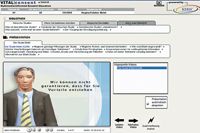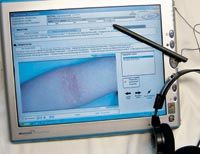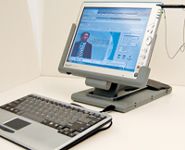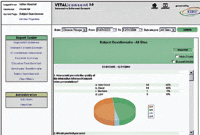The Informed Consent Process: Future Directions
Patients and patient advocacy groups have long demanded more easily understood information about their diseases and about clinical trials. Given these demands, it seems reasonable to provide trial-related information in an audio-visual format. Indeed, Brady has already reported the use of multimedia informed consent programs in several leading research centers.
Patients and patient advocacy groups have long demanded more easily understood information about their diseases and about clinical trials. Given these demands, it seems reasonable to provide trial-related information in an audio-visual format. Indeed, Brady has already reported the use of multimedia informed consent programs in several leading research centers.1
Investigators are under increasing pressure to recruit subjects for clinical trials and may face difficulties in providing each subject with an adequate amount of detailed information. This is why tools such as interactive informed consent (iIC) might benefit investigators and subjects alike. It is understood that investigators have credibility and medical expertise in the given clinical area that cannot be replaced by any tool.2 With this in mind, iIC has been introduced as a supplement to the paper-based informed consent (IC) process. The investigator still has a personal consultation with the subject after the latter has viewed the multimedia program.
The IC process is a critical factor in subject recruitment and retention. However, the text-based IC documents currently used in clinical trials are rife with shortcomings. To overcome these shortcomings (which often negatively impact recruitment and retention), some researchers now offer interactive multimedia presentations as part of the IC process. The effectiveness of a iIC program was evaluated in this feasibility case study, which involved subjects at seven German sites.
This article will discuss the methods used to evaluate this innovative technology and describe the results of the pilot trial.
Objectives of the feasibility study
Novartis conducted a pilot study to evaluate the feasibility of adopting the iIC processes. The primary objective was to ascertain how well the various site staff would embrace the new technology. Additional goals included standardization of the consent information subjects would receive and full acceptance by ethics committees (ECs) for using this innovative approach to IC. Technology-related business objectives of this pilot program included evaluations of the usability of the content, the effectiveness of the software in delivering the interactive video presentations, and the reliability of the involved hardware components (i.e., Tablet PCs).
Clinical trial outcome-related objectives were the reduction of screen failure rates and thus accelerated enrollment. Effects on patient retention were unlikely to have been observed due to a short trial duration of only two weeks. Similarly, the pilot trial was not designed to provide an estimate of the impact of the use of this technology on costs.
Selection of the solution
The Phase II clinical trial selected for this feasibility study employed a complex drug administration scheme. Therefore, the subjects required intense education about the treatment protocol. This was a perfect selection criterion for using iIC in this pilot trial. The trial was conducted at 12 dermatological clinics in Germany. Seven of the sites used the iIC to supplement the paper-based IC, and five sites used a standard paper-based IC only. Subjects at all sites also received a face-to-face consultation with a member of the research team.

Figure 3. Full screen of the Vital Consent(tm) application displaying male 3D character. Session management details are displayed on the top of the screen. Underneath are the main sections (library and presentation). Below the content window are the navigation buttons and tick boxes for autoplay mode. On-screen text is presented in the subjects local language.
Novartis selected the Vital Consent™ application from Keris, Inc. as the e-learning tool for this iIC pilot trial. The same application was used to present the e-learning modules and also track the progress of each subject through the recruitment process in real time. The vendor created the e-learning modules with input from Novartis and full consideration of 21 CFR Part 50 requirements for adequate IC.3 By incorporating photographs of the clinical site study team, the presentation is personalized and the viewer becomes familiar with team members. The strengthening of the subject-researcher relationship is considered a powerful tool for promoting subject retention.4
Subjects watching the iIC presentations used Tablet PCs (Motion 1300™, Figure 1a) equipped with headphones to listen to the audio without being disturbed. The Tablet PCs combined optimal mobility with ideal user friendliness. Viewers were able to use the Tablet PCs offline—mostly in the waiting room—and did not require a keyboard or a PC mouse.

Figure 1a. Tablet PC with touchscreen stylus and headphones provided to subjects.
After the subject completed the iIC session, site personnel set the Tablet PC into an Internet-enabled docking station (Figure 1b), which permitted an external keyboard to improve ease-of-use for site staff. Once linked to the Internet, the Vital Consent™ software transmitted tracking data to the vendor's central server. This feature allowed individual sites or the sponsor to retrieve numerous real-time reports from the Vital Consent™Report Center (Figure 2).

Figure 1b. Tablet PC linked to docking station and keyboard.

Figure 2. Screen shot of a real-time recruitment report derived from VitalConsent(tm) Report Center.
In selecting the iIC technology to be used in the pilot trial, certain requirements had to be met, including:
- The vendor must have the capability to create multimedia content for clinical trials and extensive experience in this role.
- Quality control measures must be in place.
- In-depth knowledge of pertinent regulations must be demonstrated (e.g., HIPAA, 21 CFR Parts 11 and 50).
The video content was separated into a library section and a study-specific section that included all elements of the paper IC document. The reference library contained optional clips that covered information on disease management, background information on clinical trials, and other relevant topics. A representative screen shot is displayed in Figure 3.
Near the end of the video session, subjects were asked to complete a series of true/false questions to verify their comprehension. In addition, e-questionnaires were built into the application for both subjects and site personnel to rate the usability of the Vital Consent™ technology and its associated tools in the pilot trial.
Implementation
There were numerous activities involved in the implementation of the iIC technology—all focused on supporting the site personnel. These activities included face-to-face training from the vendor to CRAs and investigators, detailed user manuals, and a responsive help desk available during local working hours.
Implementation of iIC at the clinical sites depended on obtaining EC approval at each of the seven involved research sites. The ECs at these sites unambiguously accepted the iIC content, thereby successfully fulfilling one of the operational objectives of this study. As neither ECs nor investigators requested site-specific changes to the iIC presentations, the content was highly standardized. Throughout the content development process, Novartis and the iIC vendor were mindful not to use any kind of promotional-like visual material.
Clinical results
About 51 patients used Tablet PCs offering iIC as a supplement to the paper IC. Eight additional patients did not complete the iIC, mainly for administrative reasons. As long as patients had not signed the paper IC, they were considered prescreened. Out of the pool of prescreened patients, 58 out of 59 (98%) signed the paper IC and thus became screened patients. In this group, a single patient dropped out of screening.
For the five sites using paper IC only, no data were collected for prescreened patients on a regular basis. In this group, two patients dropped out of screening. The screen failure rate is shown in Table 1.

Table 1. Patient screening failure rates
A trend towards a screen failure reduction could be detected for sites using iIC, but the pilot trial was not empowered to apply statistical analysis. The small difference between the two groups of sites has been impacted by the overall low screen failure rate of 5%, which was lower than in other comparable trials.
Questionnaire results
The usefulness of the involved technology was assessed at least in part by results from questionnaires. Of the prescreened patients, 48 out of 51 (94%) completed at least some of the eight questions. All patients (100%) reported an interest in participating in another study using iIC. The usefulness of iIC and involved hardware was rated quite high, as indicated by scores for quality of the content (100% rated "very good" or "good"), completeness of content (95% rated "complete"), appropriate duration of the presentations (67% rated the duration as "just about right"), usefulness of navigation tools, language used, and the Tablet PC itself (91% rated "very high" or "high"). An overwhelming majority (91%) stated that they would feel comfortable receiving medical information via computer in the future. Very few subjects reported minor problems, such as typos in the on-screen text. For many patients, of all the hardware and software components used, the video components worked out best (55%).
Twelve different investigators from seven sites using iIC completed at least some of the nine questions. The majority of investigators considered iIC added value to the informed consent process. Of these, 90% reported that their personal discussions with the patient took as much or less time compared to the normal text-based consent. Investigators (35%) stated that patients were better informed, and 25% reported that patients demonstrated increased compliance to the study protocol. The quality of the iIC video presentations was well-perceived (60% of investigators rated the quality as "high"). Some sites reported on transmission problems for video session data, which partly seemed to be related to the absence of dedicated high-performance Internet connections. The user-friendliness of the hardware, therefore, might need some improvement. Nevertheless, 80% of the investigators stated they would be interested in participating in another study using iIC.
Involved trial teams were asked to provide feedback via a standardized questionnaire as well. Indeed, the introduction of iIC was not considered to present an additional burden, and the adoption was considered easy.
Overall, the pilot trial provided positive results for clinical objectives as well as for technology-related objectives.
Future developments
Technical enhancements could include the generation of an on-screen text consent form that is signed via the Tablet PC's embedded keyboard. The subject could provide a 21 CFR Part 11-compliant e-signature, and a PDF format of the text IC form—including the signature—could be printed out one of the printers at the site. The patient could then receive a signed copy immediately while another copy was placed in the medical record.
Customized iIC presentations could be used in future trials as well. One example of this is collecting gender information. Once the gender of the subject has been captured in the session management screen, gender-specific versions of the presentation are delivered (e.g., female patients would be offered sections on contraceptive precautions during the trial).
By introducing animated slideshows, one might satisfy e-learning requirements for rapidly changing content.
The added value of iIC
This pilot study dealt with using iIC for subjects with atopic dermatitis. Disease-related video presentations have been reported to enhance the IC process for subjects with other diseases as well, such as glaucoma.
5
Clearly, it is the iIC process itself, not the specific disease, which makes it an effective adjunct to traditional consent sessions. Published studies report that alternative methods for obtaining IC such as multimedia systems are considered to provide substantial benefit to subjects.
6
The current paper-based IC process is highly regulated. Using iIC can be considered a breakthrough in improving IC without impacting the current paper-based system. iIC can overcome the weaknesses in the existing paper-based processes, such as subjects' limited comprehension and a lack of standardized information across sites. An additional advantage of the applied e-learning tool is the documentation of the comprehension by the subject. If required, tracking information could be retrieved to document which presentations a subject had viewed or repeated.
Subjects appear to have neither qualms nor boundaries towards using this kind of technology. Respondents in this pilot study stated they would use computers in the future for retrieving health care-related information. Similarly, Eilenberg et al.7 reported on patients using interactive Web-based IC with high satisfaction rates.
It is well known that pharmaceutical companies invest heavily in recruitment activities.8 Although iIC should not be considered strictly a recruitment tool, one would expect significant improvements in screen failure rates and retention rates in large-scale trials—providing the sample size is sufficient to detect these effects.
The selected pilot trial was not powered to provide robust data on screen failure rates or even retention rates. However, additional prescreening data could be collected without additional effort, and a trend towards reducing screen failures rates was determined in this trial.
As all objectives of this feasibility study were fulfilled, the trial was considered a success. The standardization of the IC information and delivery was achieved. All sites received an identical video presentation, with the exception of a brief site-specific welcome clip. Subjects seemed to be highly satisfied with using iIC video presentations as a source of valid information. Because of this, cooperation of the subjects with the research sites improved, and investigators and site personnel provided very positive feedback about the experience.
Ethical guidelines prohibit clinical trial sponsors from influencing the relationship between subject and investigator. Nevertheless, the use of iIC was accepted very well by ECs and required no alterations to the proposed content. The usefulness of the content as well as of the software application was rated very highly. All parties involved in this trial confirmed the added value of using iIC in this study.
Additional pilot trials would be required to collect more data on screen failure rates, enrollment and retention rates, and potential associated cost savings. It would be interesting to expand the scope of future iIC pilot trials to include pediatric patients who cannot be expected to legally provide consent, but who could provide their assent instead. In addition, visually impaired patients could benefit from iIC video presentations as they would not have to receive a text-based document as the source of information only. Moreover, certain technology-related extensions (e.g., e-signature of the IC document) could be evaluated. This could help to further improve the IC process for the good of subjects, sites, and the sponsor as well.
References
1. J.S. Brady, "Multimedia Delivery Can Enhance the Consent Process,"
Applied Clinical Trials
, 36-42 (January 2003).
2. F. Kermani and P. Bonacossa, "New Ways to Recruit Trial Subjects," Applied Clinical Trials, 38-42 (February 2003).
3. J.S. Brady, "A Better Way to Get Consent," Pharmaceutical Executive, 68-74 (December 2003).
4. M. Jervis, "Keeping Subjects Motivated: It's All in the Relationship," GCP Journal, 3-4 (March 2003).
5. M. Greenberg, "How Videos Can Help to Inform Patients' Consent in Clinical Trials," GCP Journal, 28-29 (August 2003).
6. M. Paasche-Orlow, H.A. Taylor, F.L. Brancati, "Readability Standards for Informed Consent Forms as Compared with Actual Readability," New England Journal of Medicine, 348, 721-726 (2003).
7. KL. Eilenberg, A.M. Hoover, M.L. Rutherford, C.A. Melfi, S. Segal, "From Informed Consent Through Database Lock: An Interactive Clinical Trial Conducted Using the Internet," Drug Information Journal, 38, 239-251 (2004).
8. S.L. Szeinbach and T. Miller, "Recruitment Strategies in the Pharmaceutical Industry," Drug Information Journal, 38, 33-38 (2003).
Volker Möckel,PhD, MSc, is with Clinical Development & Medical Affairs, Novartis Pharma, Lichtrasse 15, CH-4002 Basel, Switzerland, email: volker.moeckel@pharma.novartis.com.
FDA Fast Tracks Johnson & Johnson’s Nipocalimab for Fetal Neonatal Alloimmune Thrombocytopenia
March 27th 2024Johnson & Johnson is moving forward with a pair of Phase III trials of nipocalimab to reduce the risk of fetal neonatal alloimmune thrombocytopenia in alloimmunized pregnant patients.
